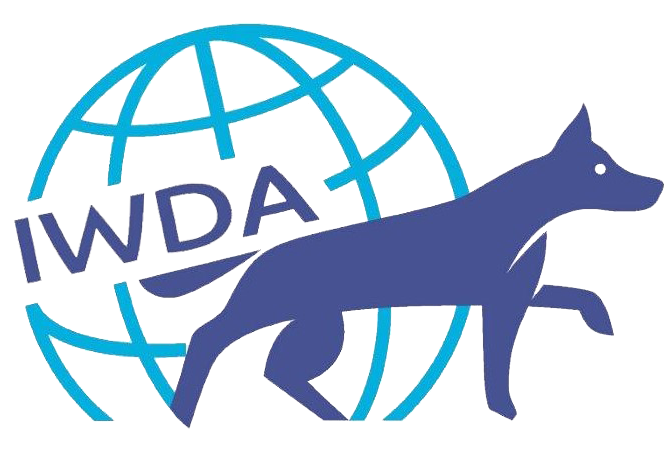Search for working dog conference recordings, articles on health, breeding, socialization and organizational management, webinar recordings and more.
Old Conference Archive Page | View all IWDC 2023 Recordings | View all Breeder's Workshop Colorado Recordings
-
Organization Management
-
Canine Resources
-
- Articles coming soon
-
-
- Emotional Conflict During Socialization
- What is environmental enrichment?
- Distance, Distraction and Duration
- Developing Foundational Skills
- Luring, Marking & Giving Food
- 5 Steps to Progressing Skills
- Dog-Human Relationship Skills
- Utilizing Volunteers
- Biosecurity
- Biosecurity protocol documents
- Example Socialization Schedule
- Puppy Socialization Tracker
- Crate Training
- Managing Inappropriate Interactions between littermates
- Preventing and Fixing Door Dashing
- Follow Me: Video
- Bath Progression: Video
- Intro to New Environments: Video
- Motor Development: Video
- Novel Objects: Video
- Novel Sounds: Video
- Trolley Ride: Video
- Wearing Things/Coat Desensitization: Video
- Carrying Puppies Safely
- Safely Using Stairs: Video
- Puppy Confidence Course
- Socialization Ideas Gallery
- Weighing Puppies: Video
- Birth of a Puppy: Video
- First Time Outside the Den: Video
- First time Exploring the Garden: Video
- Exploring the garden in the dark: Video
- Include puppies in the daily work routine: video
- Collar Habituation: video
- Exploring a wobble board
- Exploring the world - unfamiliar surroundings
- Walking around the grounds
- Socialization opportunities in daily life
- Walk in the woods
- Exploring the world
- Free time for moms
- Explore the stairs and garden
- Explore the puppy garden
- Show Remaining Articles ( 28 ) Collapse Articles
-
- Articles coming soon
-
Education
-
-
- A Behavioral Questionnaire for Selection and Study of Odor Detection Dogs - Presented by Cynthia Otto
- Audeamus PTSD Service Dogs, ACAC Accredited Peer-Support Model for Veterans and First Responders - Presented by Chris Lohnes and Grace Rath
- Audeamus Service Dogs and University of Saskatchewan Research Partnership and Outcomes - Presented by Chris Lohnes & Grace Rath
- Building a Purpose Bred Breeding Program - Presented by Allison Peltier and Rachel Goldammer
- Core body temperature and activity level changes during work and exercise in patrol dogs of the Queensland Police Service - Presented by Jayne McGhie
- Detection of Heterobasidion parviporum scent samples in indoors scent discrimination test by trained volunteer dog-handler teams - Presented by Heli Väätäjä
- Development of a Tool to Aid in the Selection and Pairing of Breeders based on Behavioral Traits - Presented by Jordan Smith
- Early Detection of Heat Stress in Working Dogs - Presented by Andrea L. Henderson
- Effects on behavior and physiology of handling style during veterinary visits - Presented by Karen Overall
- Field cooling for exertional hyperthermia - Presented by Cynthia Otto
- From Anxious to Resilient: The Role of Dynamic Interactive Engagement in Shaping Military Working Dogs - Presented by Melanie Uhde
- Genetic Resources to Improve Dog Health - Presented by Angela Hughes (Royal Canin)
- Genomic research in the Working Dog Field: Combating Canine Cancer through Collaboration and Comparative Oncology Research - Presented by Frances L. Chen
- Handler Perceived Risks to Operational Detection and Patrol Police Dogs - Presented by Jayne McGhie
- Improving Trauma Patient Care - Presented by Kelly Hall
- Neuromuscular Balance Training in Working Dogs - Presented by Andrea L. Henderson
- Occupational Risks and Specialized Veterinary Care for Working Dogs - Presented by Cynthia Otto
- Putting working dog research into practice: development of science-based guidance notes - Presented by Fiona Williams
- Rating of Perceived Exertion in Working Dogs - Presented by Andrea L. Henderson
- Real-world experience with liquid biopsy testing for cancer detection in working dogs - Presented by Jill Rafalko
- Specialty Practice Behavioral Problems and Outcomes in Companion Dogs - Implications for Working Canines - Presented by Walt Burghardt
- Start of life – Feeding during pregnancy and lactation to increase reproductive success - presented by Angela Hughes (Royal Canin)
- Teaching Collar Yielding as a Foundation Behavior - Presented by Patrick Glines
- The Doberman Diversity Project: a Citizen Science approach to breed improvement - Presented by Sophie Liu
- The effect of inhibitory control, arousal, and affective state in Military Working Dogs Performance - Presented by Astrid Concha
- The effect of training aid volume on odor generalization in detection of chronic wasting disease in deer - Presented by Mallikarjun and Wilson & Cindy Otto
- The Many Dogs Project: A Big Team Canine Science Effort - Presented by Sarah-Elizabeth Byosiere
- Transformative Power of Freedom of Choice in Changing Behavior - Presented by Marty G. Roache
- Turning a Critical Eye on an Established Breeding Program to Improve End Results Using IWDR - Presented by Natalie Ergler and Rachel Goldammer
- U.S. Military Working Dog Welfare - Presented by Desireé Broach
- What is the future of Biological Detection Canines? - Presented by Heather Junqueira & Ken Furton
- Working dog memory and canine gut microbiome - Presented by Xu Wang
- Show Remaining Articles ( 17 ) Collapse Articles
-
- Breeding Healthy Dogs - Presented by Madeline Zimmermann
- Choosing What to Breed For - Presented by Madeline Zimmermann
- Gaiting - with Doug & Colton Johnson
- Genetic Merit Selection - Presented by Madeline Zimmermann
- Improving Behavior - Presented by Jane Russenberger & Dr. David Roberts
- IWDR: Storing your Data - Presented by Rachel Goldammer
- Keep Data on Everything! - Presented by Rachel Goldammer
- Long-Term Colony Management: Balancing genetic improvement breeding for the whole dog - Presented by Dr. Eldin Leighton
- Power of Numbers: IWDR Functions - Presented by Rachel Goldammer
- Producing Puppies - Presented by Dr. Fiona Hollinshead and Dr. Greg Burns
- Puppy Socialization - Presented by Jane Russenberger
- Puppy Socialization for Handling - presented by Doug & Colton Johnson
- Reading Dog Behavior/Emotional States - Presented by Dr. Karen Overall
- Whelping and Neonatal Care - Presented by Dr. Fiona Hollinshead and Dr. Greg Burns
-
- "All about the boy" - Semen Collection and Analysis - presentation by Dr. Fiona Hollinshead
- All about the brood - presentation by Dr. Greg Burns
- Behavior Checklist (BCL) Workshop - with Helen West
- Behavioral scoring in Puppy Raising - presentation by Helen West
- Brood and Whelping Concerns - presentation by Dr Greg Burns
- Calculating Differential Risk of Osteoarthritis in Dogs with Low vs High Hip Scores - presentation by Dr Tom Lewis
- Cardiac diseases - presentation by Dr Kevin Conrad (absent); presented by Dr. Kyle Quigley
- Conditioning Program for Dogs Coming In For Training - presentation by Dr Kevin Conrad (via zoom)
- Critical periods of socialization and impact on temperament of the dog - presentation by Jane Russenberger
- Does early potty training affect indiscriminate relieving? - presentation by Dr Lynna Feng
- Dog behavior is in the eye of the beholder - presentation by Joke Monteny
- Entropion - presentation by Jenna Bullis
- Feeding for Breeding Success - presentation by Dr. Emmanuel Fontaine
- Gait and Structure Evaluation for Guide Dogs - presentation by Peggy Gibbon and Dr Katy Evans
- GDBart Puppy Test - presentation by Helen West
- Healthy microbiome and faecal transplants - presentation by Dr Kevin Conrad (absent); presented by Dr Caroline Moeser
- Hip and elbow assessments - with Dr Bart Broeckx
- How to make breeding decisions on traits without EBVs - presentation by Madeline Zimmermann
- How to use estimated breeding values successfully - presentation by Madeline Zimmermann
- Improving behavior with EBVs: Body sensitivity, Noise Fear, Inhibited by Stress, Activated by Stress, Excitable - presentation by Jane Russenberger
- Improving health using EBVs: Elbow, Skin and Mast cell tumours - presentation by Madeline Zimmermann
- Is it really epilepsy? - with Dr Bob Proesmans & Dr Caroline Moeser
- Neonatal Care - presentation by Dr Emmanuel Fontaine
- Reproductive Trends and Cryogenic Insights from Guiding Eyes - presentation by Clover Williams
- Selecting Reproductively Healthy Dogs - presentation by Dr Emmanuel Fontaine
- Skin allergies - with Dr Caroline Moeser
- Stargardt's disease in Labrador retrievers - with Dr Katy Evans
- Strategies for genetic diversity - presentation by Jackie Clark and Dr Bart Broeckx
- Superficial Digital Flexor Tendon Avulsion - presentation by Dr Caroline Moeser
- The art of insemination - presentation by Dr. Fiona Hollinshead
- The Overall Selection Index - presentation by Dr Eldin Leighton
- What influences semen quality? - presentation by Dr. Tom Lewis
- Show Remaining Articles ( 17 ) Collapse Articles
-
- A detailed evaluation of Spotted Lanternfly (Lycorma delicatula) detection dog training and performance - Presented by Edgar O. Aviles-Rosa
- A novel method for the detection of Japanese knotweed (Reynoutria japonica) using specially trained canines - Presented by Kat Janczur
- AKC Detection Dog Task Force Program: Working with AKC Breeders to Improve Breeding & Availability of Explosives Detection Dogs - Presented by S Goffe
- Assessing working dog fitness with the Penn Vet Working Dog Center Fit To Work program - Presented by Brian Farr
- Assessment of the Agreement between Fosters and Trainers Evaluating Behavior with the C-BARQ and Behavior Checklist presented by Elizabeth Hare
- Behaviour Assessment and IWDR - Presented by Dr Jane Russenberger
- Breeding Strategies and Advanced Reproductive Techniques to Optimize Production of Improved Generations of Specialized Canines at Three major working dog breeding programs in New Zealand - presented by Dr Fiona Hollinshead
- Development and heritability of cognitive traits in Canine Companions dogs presented by Emily Bray
- Digital innovation for working dogs - Presented by Dr Mia Cobb
- Discrimination between SARS-CoV-2 infection and other viral respiratory infections by working dogs - Presented by Nele ten Hagen
- Effect of impulsivity and core effect on training performance in dual purpose military working dogs - Presented by Astrid Concha
- Epilepsy in working dogs - Presented by Prof Holger Volk
- Estimated Breeding Values in IWDR - Presented by Dr Eldin Leighton
- Examining the Role of Significant Others in Canine Welfare within the Context of Veterans Working with Service Dogs - Presented by Linzi Williamson
- Explosive detection canine operational requirements and performance degradation: expert perspectives - Presented by Brian Farr
- Hot Topics in Working Dog Care - Presented by Dr B. Pierce & Dr K. Mann
- Implementation of a plan to decrease arousal and increase motivation - Presented by Robert Dougherty Jr and Alena Heyer
- Improving behavior monitoring within a working dog program - Presented by Becky Hunt
- Incidence of enteric pathogens versus presence of gastrointestinal symptoms in a working dog training facility - Presented by Dr Nicola Cotton
- Investigation of tail injury at Lackland Air Force Base Training Kennels for Military Working Dogs - Presented by Marty G. Roache & Karen L. Overall
- Learning to Smell: Impacts of Training and Experience on Detection Dog Performance - Presented by Nathaniel Hall
- Lecture on Generalization in Detection Work - Presented by Hans Ebbers
- Liquid biopsy screening for early cancer detection in working dogs - Presented by Katherine M. Lytle, DVM, MPH, MS
- Military Working Dog Aggression and Welfare - Presented by Desiree Broach
- Multimodal characterization of detection dog suitability: Combining behavioral, cognitive, and neurological measures for enhancing selection - Presented by Lucia Lazarowski
- Overview of the IWDR for Working Dog Organizations - Presented by Dr Eldin Leighton
- Pandemic or pandemonium? Creating standards for medical detection dogs - Presented by Dr Cynthia Otto
- Penn Vet Working Dog Center Fit To Work program foundational fitness development and training - Presented by Meghan Ramos
- Preliminary Accuracy of COVID-19 odor detection by canines - Presented by Kenneth G. Furton
- Prevalence of Canine Degenerative Myelopathy SOD-1 Mutation in Working Shepherd Dogs across Australia and New Zealand - Presented by Jayne McGhie
- Scent dog identification of SARS-CoV-2-infections- a double blind study - Presented by Esther Schalke
- Solving cold-cases: Dogs can match human scents collected several years apart - Presented by Margot Perez
- The Application / Practical Implementation Pro/Cons of Covid-19 Olfactory Detection Dogs - Presented by Prof D Grandjean
- The Domestic Breeding Consortium: Odor Detection Canine Selection, Breeding, and Early Training Techniques - Presented by Karen Meidenbauer
- The effect of maternal style on later puppy behavior in Canine Companions dogs - Presented by Brenda Kennedy
- The use of historical health records at The Seeing Eye in genome-wide association studies for canine health traits presented by Katy M. Evans
- Training with Varying Odor Concentrations: Implications for Odor Detection Thresholds in Canines - Presented by Mallory DeChant
- Transitioning a Therapy Dog Program Online: What's In It For the Dog? - Presented by Ben Carey
- Using IWDR's Advanced Tools to Improve HeaLth and Behaviour - Presented by Dr Eldin Leighton
- Using Single-Step Genomic BLUP to Compute Genomic Enhanced Breeding values for Self-Modulation in Working Dogs presented by Molly Riser
- Using trained dogs and organic semi-conducting sensors to identify asymptomatic and mild SARS-CoV-2 infections - Presented by Dr Claire Guest and Prof James Logan
- Working Dog Welfare: Where are we now and where are we going? - Presented by Dr Mia Cobb
- Show Remaining Articles ( 27 ) Collapse Articles
-
- A canine thermal model for mitigation of heat strain in working dogs - Presented by C. O'Brien
- Building a better detector dog: Lessons learned and (many) questions remaining to be explored in Auburn University’s 19 years of detector dog production - Presented by P. Waggoner, PhD
- From Puppyhood to Adolescence: Longitudinal Cognition Study at Canine Companions for Independence - Presented by K. Levy
- Genome-wide association studies to identify loci and variants associated with behavioral traits in dogs - Presented by V.D. Marinescu, PhD
- Hyper-reactivity in military working dogs: a report of two cases - Presented by O. Soares, DVM, PhD
- Measuring, and determining factors affecting performance of glycemic alert dogs - Presentation by N. Rooney, PhD
- Neuromotor development in puppies: implications for training and fitness - Presented by B. Pierce, DVM, MS, DACVIM, DACVP, DACVSMR
- Odour generalisation – theory and practice - Presented by A. Schoon, PhD
- Putting working dog research into practice: development of science-based guidance notes - Presented by V. Ratcliffe, PhD
- Referential focus - pet & working dogs - Presented by K. Overall, MA, VMD, PhD, DACVB
- Statistics for working dogs – how do you know if your test/assessments are better than a coin toss? - Presented by A. Dunham, PhD
- Temperament and EBV - Presented by Erling Strandberg, PhD, SKK
- Testing dogs for behaviour in Sweden: Canine temperament - assessment and heritability & How you assess temperament - presented by Åke Hedhammar DVM, PhD & Kenth Svartberg, PhD
- The chemistry of odor: How understanding odor can foster a better detector - Presented by L. De Greeff, PhD
- The opioid crisis and working dogs - Presented by C. Otto, DVM, PhD, DAVCECC
- What helps and what hinders assistance dog/puppy raising practices? - Presented by Doc Loc Mai (Jimmy)
- Working Dog Centre: Working hard for working dogs - Presented by W. Baltzer, DVM, PhD
- Show Remaining Articles ( 2 ) Collapse Articles
-
- BCL Workshop with Rachel Goldammer
- Anchor at Sea: Breeding for the Whole Dog - presented by Dr Eldin Leighton
- Picking and Managing Breeder Candidates - presented by Madeline Zimmermann
- GDB Whelping Box Fleece and Hip Dysplasia Study - presented by Dr. Kris Gonzales and Lauren Holtz
- The Importance of Longitudinal Behavioral Data - presented by Dr. Dave Roberts (NCSU), Jane Russenberger
- Lifetime Health Data: Critical for Your Decision-Making - presented by Jane Russenberger
- Fighting Cancer with Genomics: Developing Breeding Values to Reduce Hemangiosarcoma Risk and Unlocking DNA insights - presented by Frances Chen
- Discovery of Early On-Set PRA - presented by Glenna Fiddyment
- Suspected autosomal recessive primary ciliary dyskinesia in a colony of Labrador Retriever guide dogs - presented by Katy Evans
- Small Litter Whelp Protocol and Utilizing Best Practices in a 24-Hour Whelping Facility - presented by Kristine Gonzales
- Genetic and genomic investigations into canine atopic dermatitis - presented by Dr Tom Lewis
- Puppy Socialization Application with limited Staff and Resources - presented by Natalie Ergler, Guide Dogs of America
- Low-Pass Whole Genome Sequencing: Equipping the Working Dog Field with Next-Generation Genetic Tools Through Research Partnerships - presented by Frances Chen
- Smart Collar Project - presented by Dr. Dave Roberts
- Canine Genetics And Genomics: A Primer - presented by Dr Eldin Leighton
- Harnessing the Power of Longitudinal Data in IBC: Insights, Challenges, and Applications - presented by Dana Hunter
- Repro Techniques Demonstration and Discussion: Examination of the male - presented by Dr Gary England
- Repro Techniques Demonstration and Discussion: Examination of the female – presented by Dr Gary England
- Show Remaining Articles ( 3 ) Collapse Articles
-
- Unifying the Canine Detection Community: The Impact of Standard Development on Global Practices - Presented by Paola A. Prada-Tiedemann
- Utilizing scent detection dogs in the early detection of Ips typographus damages - Presented by Reetta Kangaslampi & Dr Olli-Pekka Tikkanen
- The Detection of Oil Under Ice and Water by Oil Detection Canines - Presented by Paul Bunker
- Quality Management and Deployment of Mine Detection Dogs: NPA Approach - Presented by Kenan Muftic
- Breeding on a (Shoestring) Budget - Presented by Patrick Glines
- Remote detection - Presented by Jens Frank
- From Laboratory Insights to Operational Efficiency - Presented by Joshua Araujo
- Foundational Skills for Greater Success in the Working Dog - Presented by Jane Madigan
- What olfactory psychophysics and ethology can contribute to work with sniffer dogs - Presented by Simon Gadbois
- The impact of distraction training on dogs’ learning and task performance - Presented by Carla Hart
- Training a cadaver detection dog - Presented by Hans Ebbers & Marco Muglia
- Vapor Diffusion in Soil: Simulated Explosive Burials and Canine Trials - Presented by Emma Calabrese
- Optimising Police Dog Breeding and Development for Operational Performance - Presented by Scott Bruce
- Building Successful Partnerships with Private Breeders for Working Dog Programs - Presented by Laura Edwards
- Lessons learned from training dogs to detect plants - Presented by Kat Janczur
- Identifying when early puppy behaviors deviate from ‘normal’ and implications for development of behavioral pathology - Presented by Karen Overall
- Collaborative canine genomics: developing the next generation of genetic selection tools in working dogs - Presented by Frances Chen
- Genomic estimated breeding values on health and behavior traits to inform breeding and management of working dogs - Presented by Heather Huson
- Overview of maintaining genetic diversity - effective population size - practical applications in a breeding program - Presented by Tom Lewis
- Human Animal Bond- Contact-Free Simultaneous Sensing of Human Heart Rate and Canine Breathing Rate for Animal Assisted Interactions - Presented by Dave Roberts
- Dietary Management of Working Dogs: More than Just Calories - Presented by Erin Perry
- UK ISAR Dogs in the 2023 Türkiye-Syria Earthquake Response - Presented by Lyndsay Sielski
- Understanding and meeting the welfare needs of working dogs - Presented by Sam Gaines
- Decoding Disease Detection - Presented by Claire Guest
- Mind the Gap: Human Perceptions, Canine Preferences, and the Importance of Welfare Assurance in Working Dog Programs - Presented by Mia Cobb
- Stress travels down the lead but also through the air - Presented by Nicola Rooney
- Suspected autosomal recessive primary ciliary dyskinesia in a colony of Labrador Retriever guide dogs - Presented by Katy Evans
- Nutritional Needs of Working Dogs - Presented by Caroline Burke (Royal Canin)
- An examination of the latest research relating to kennelled dog welfare - Presented by Dr Jenna Kiddie
- Can a synbiotic provided to puppies affect the incidence of diarrhoea during the transition from nest to puppy raiser? - Presented by Madeleine Goumas
- MWD Functional Assessment - Preserving the Fighting Force - presented by Andrea Henderson
- From Can't Get Right to Law Enforcement K9 - Daniel's Story - presented by Marty Roache & Angel Landrau
- Multi-modal Treatment of Diarrhoea and the Importance of the Microbiome - Presented by Michelle Van Lienden
- Show Remaining Articles ( 18 ) Collapse Articles
-
-
-
- Veterinary Genetics with Dr Angela Hughes
- Optimizing Volunteers for Early Socialization Success with Liz Rote
- Inbreeding in Working Dog Colonies with Dr Eldin Leighton
- Partners in crime - help puppy raisers turn fun policing upside down - with Matthias Lenz
- Improving Digital Processes and Datakeeping for Volunteers and Working Dog Programs - with Dani Prebensen
- Walk and Talks: Beyond the Data - with Jackie Clark
- Building a Healthy Relationship with Your Nonprofit Board - With Laura Edwards
- Identify and Build a Healthy Nonprofit Board – With Laura Edwards
-
-
-
Payment and Accounts
Quick Reference Guide

Goal
Add variety in body handling, develop hearing skills & confidence in new environments.

Environments
Den, or brief 1-on-1 excursions outside den with a familiar handler. If another room is not available, a puppy-proofed area that is able to be sanitised between uses is also suitable.

Volunteer Activities
Interactive activities can be done by experienced volunteers or staff. Experienced handlers should be utilized for one-on-one sessions and introductions to new environments.
Introduction
Rapid physical and behavioural development occurs this week. As pups become more mobile and extend their exploration of their den, utilize this time to offer more variety and challenges for the pups. Make sure you’re familiar with our guide to Emotional Conflict during Early Socialization.
- Body handling will offer more variety in items used.
- Massage continues to build up a positive human relationship as well as teaching pups how to cooperate with humans and not wiggle when being held or handled.
- Their sense of hearing is improving so this week gently build skills around hearing.
- Promote confidence and calm acceptance of unfamiliar environments
- Use a familiar handler if pup is taken briefly outside the den for 1 on 1 away from littermates. One-on-one sessions and introductions to new environments can be big challenges for puppies at this age, so make sure your handlers understand puppy body language and know how to support the pups through these activities.
- Addition of unfamiliar sounds, surfaces, and textures are accepted without issue, including a calm acceptance of massage and textures over body.
- Pup is engaged with the handler or environment most of the time (not hiding, overly stressed, or shutting down). Pup’s confidence will increase as it interacts and learns that its environment is constantly changing .
- Alternatively, pup is conflicted briefly then moves back into the green zone once it has resolved the internal conflict. (Pup displays 1 or 2 stress signs (yawning, whining) it quickly resolves inner conflict without escalating to additional stress signals; Second exposure pups are more confident with a reduced number of stress signals. Look for an improvement in the pup’s confidence with each exposure to the stimuli. If the pup has displayed 2 or 3 stress signals, set pup up for success and aim for less next time by building the pup’s confidence.)
For more information on puppy engagement during socialization, read our article on Emotional Conflict During Socialization here.
Pups still need large amounts of sleep. Do not over stimulate the pup. It cannot learn in this mode
Utilise the natural curiosity of young pups when introducing new environments and build up positive association around change prior to the startle/fear stage that occurs later.
Observe pup and adjust procedure appropriately so it is a positive learning experience. Each pup is worked as an individual and techniques are for this pup not the whole litter.
Early repeat exposure in different environments will add to pup’s confidence and ways to resolve inner conflict.
Keep it brief: Remember pups have short attention spans. A successful exposure may be only seconds long and an entire education session should be no more than 5 minutes.
Keep your objective in mind: Since puppies have short attention spans, it is important to focus on the task at hand. While it is very tempting to snuggle a puppy before working with them, this can take away from the puppy’s purposeful learning for the day as they are able to work for noticeably short periods of time
Give the puppy an “escape route”: When an activity has gone on too long, is too overwhelming, or too challenging, a puppy needs a means to avoid it. If a puppy uses the escape route frequently, stop and seek assistance. Large objects, tunnels, gap behind crate can offer a pup a safe area to resolve their inner conflict.
Adaptability is an important skill in working dogs. Teaching pups to accept daily changes in environment, handling and routine during this age group will help them generalise to any environment in their working life.
Teaching pups to interact with their environment without overreacting is an important skill in producing sound working dogs.
Teaching these skills during the early critical learning period will produce better results than introducing it after 12 weeks of age when pup is not as adaptable to changes.
Increasing the pup’s repertoire of positive associations around new and novel objects and environments will result in resilient dogs.
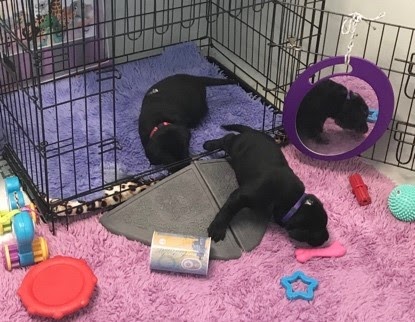
Problem Solving
- Allow pup time to resolve inner conflict themselves
- Offer emotional support via voice and touch
- Shorten duration of visit. If one pup displays distress signs (whining) the others will usually follow. Be prepared to move when all pups are quiet so as not to reinforce a negative behaviour (whining gets what I want)
- Engage with pup using favourite toy
- Look for an improvement in the pup’s confidence with each exposure to the stimuli. If the pup has displayed 2 or 3 stress signals, set pup up for success and aim for less next time by building the pup’s confidence.
Stop and place hands around pup’s chest area. Do some gentle circular motion with your hands. Once pup is calm again you can resume the body handling.
It can help to go back to an area on the body that pup is comfortable being handled and try again.
Should pup still not be comfortable reduce the session times then build up again.
Try luring with slower, more deliberate movements. Make sure you have pup’s interest in the lure and maintain that connection. Practice moving your arm with a “mixing bowl” movement – wide, sweeping and steady.
- Review our massage and body handling protocols. Make sure you’re not progressing too quickly. Ensure that the massage is no longer than 1 minute. Reduce time then slowly build up again.
- Are pups touched prior to being lifted off ground for weighing? Petting the pup before handling can help avoid startling the pup.
- Ensure all staff move pups slowly and each pup is fully supported. Make sure not to move pups quickly through the air.
- Place another pup next to the pup being massaged for a familiar scent.
- Use a small piece of whelping mat that has been left under puppies. Familiar scent will be on the massage whelping mat.
During these early weeks, you can encourage mom to come near the puppies. If puppies continue to show stress signs, move puppies closer to their mother and littermates.
If puppies are regularly “getting lost” or “stuck” away from mom and littermates, you may have too many passive environmental enrichment items in the den. Reduce the number of items or the complexity of the environment.
Has time been spent with the Brood prior to her Whelping in order to build up positive associations? Pre-whelp is a good time to massage the Brood especially around her side and towards her glands where pups will feed. Relaxation music can be helpful as well as introducing the Brood to the initial sounds her pups will experience once their ears open. Once you know how your brood is likely to react for future litters, spend additional time with her in the pre-whelp stage preparing her for the weeks ahead.
Your brood will need to leave the den briefly to toilet, stretch her legs or eat – use this opportunity to work on some socialization activities or re-arrange the passive environmental enrichment stimuli in the den.
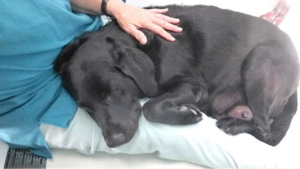
Passive Environmental Enrichment
Passive exposure continues by exposing pups to a variety of surfaces, sounds, movement, objects in their crate and den environment.
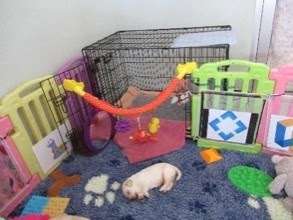
Acceptance of change and difference can be achieved by placing 1 random object into the nest each day that the puppies have not been exposed to before (backpack, hat, purse, statue like objects). Observe and record each pup’s reaction to the novel object.
Below we have marked each activity with one to three ✓. Although all activities are important, we have highlighted activities that are particularly critical during this period of the puppies’ development. Make sure you still offer the pups a wide variety of activities and do not only focus on those with the most ✓!
Working dogs must be accepting of a variety of novel objects they may encounter in the community; so, it is important that at an early age they begin to build their reference library of unusual items, including those that move, so that they are comfortable and confident with different novel objects.
- When exposing pups to new sounds, think about variety. Music can include jazz, classic, country, pop, or simply putting on the radio.
- Playing the news or weather report on the TV or radio exposes pups to different voices and different types of sound.
- Music can be played quietly on a radio or computer in the same room as the whelping box for half an hour per day.
- Safe objects that make noise can also be placed in the whelping box.
- If Mom is uncomfortable with items or will chew items up, only place them in the den under supervision for a short period of time.
Note this video covers multiple age groups. Please see the section from 1:16 – 3:07 for content appropriate for this age group.
Continue to add new surfaces each day or change the placement of the surfaces
- Smooth slippery surfaces are not suitable as this age as pups have only started walking and will be unsteady on their feet
- Passive crate exposure, uneven surface (ramp into crate), small red wobble toy, tin that rolls, a mirror can be added to den to provide variety
Add more variety as the pup’s eyesight improves by the use of visual stimulation walls or by changing the location of items around the room.
- Hanging mobiles for passive coat desensitisation and noise – change the position each day, then add a new hanging toy and repeat the process throughout the week.
- Change to new visual pictures on the wall or change position around the room so the pups environment is constantly changing. Acceptance of change will help to build a resilient dog.
Ensure you introduce a large variety of new people, start gradually to build up pup’s acceptance of difference. Demographics to cover include; young, elderly, male, female, toddlers, different ethnic groups.
At this age, exposure to different people may be limited to a few reliable volunteers and staff members. Focus on making any interaction calm, positive and rewarding for the pups. In the following weeks, we’ll drastically increase the variety of people puppies are introduced to.
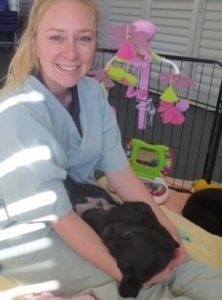
Interactive Activities
The development of purposeful play will start this week (pups become aware of Brood and litter mates this week so we will see more puppy-like behaviour) with littermates exploring novel objects, sound objects, motion objects, and surfaces.
Start with soft gentle sounds, like baby rattle, as ears are not fully opened. Add more variety of items so pups will continue to develop positive experiences around body handling, and puppies can build positive association with new objects and sounds. Every interaction with the puppies continues the building of handler engagement.
Below we have marked each activity with one to three ✓. Although all activities are important, we have highlighted activities that are particularly critical during this period of the puppies’ development. Make sure you still offer the pups a wide variety of activities and do not only focus on those with the most ✓!
Handler can throughout the day not engage with pup but still provide variety by
- Knocking on the door when passing the den.
- Make other random sounds throughout the day e.g. when going in den for other duties like health checks, weighing pups, changing bedding
- Rattle hanging toys, bang two objects together to make an unexpected noise, drop objects, pretend to cough, laugh or sneeze.
- Play sound clips from a Youtube play list to expose puppies to some different or random sounds
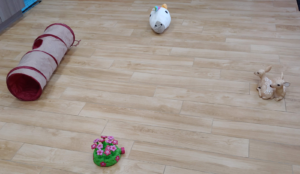
Goal: To allow puppies to explore multiple novel objects with a handler and to be comfortable with novel objects.
To prepare your designated space for this activity, please complete the following steps.
- Gather 5 novel objects. Remember variety when selecting objects.
- Arrange the objects in a circle spread apart enough for the puppies and handler to move around comfortably.
You are now ready to retrieve the litter of puppies you are working with.
- Allow the puppies to explore the room upon entering for up to a few minutes (consider needs of the puppies!).
- Invite the puppies to explore each of the objects with you.
- Continue around the circle in the same manner.
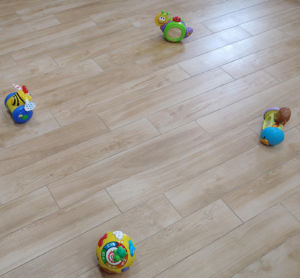
Goal: To allow puppies to explore multiple sound objects with a handler and to be comfortable with a variety of sounds.
To prepare the designated space for this curriculum, please complete the following steps.
- Gather 5 noise objects and 2 handheld noise objects. Remember variety when selecting objects.
- Place the handheld noise objects on a nearby counter or out of puppies’ reach.
- Arrange the objects in a circle spread apart enough for the puppies and handler to move around comfortably.
You are now ready to retrieve the litter of puppies you are working with.
- Allow the puppies to explore the room upon entering for up to 30 seconds.
- Use the hand-held noise objects when the puppies are playing and exploring the room.
- Encourage the puppies to explore each of the objects with you.
4. Continue around the circle in the same manner
It is important to start to build a solid foundation of skills. Body Handing is ongoing and involves lots of practice. It can be done in short sessions throughout the day in order to set the pup up for success by keeping skill training fun and expectations consistent. Body handling is the process of teaching our puppies to accept all parts of their body being handled while remaining calm while we touch and move all parts of their body.
This is beneficial for health/Vet visits. These skills also help with body sensitivities to equipment the pup may need to wear such as boots or coat.
Remember, Body handling should be a calm, gentle process – it’s not a time for cuddles or play – that can come later! Take extra care around your pup’s teeth, ears and paws – these areas are crucial for Body Handling but many pups find the handling of these areas strange at first.
Start by Teaching the “Close” position: (Note at younger ages puppies may need to be put in this position to begin the exercise. With age, pups can be taught how to manoeuvre into that position using the lure as described below.)
- Start by crouching on the ground with the puppy in front of you, facing you.
- Place your right knee on the ground – If pup is on a lead put the lead under your knee so both hands are free 3. Use your left hand to lure the pup from your right knee in a circle until they are between your legs facing away from you
- Tilt your lure back over the pup’s head so they go into a sit
- Mark and pay
- Put your knee down so you are kneeling with pup sitting between your legs and place your two hands on the pup’s chest
- Repeat steps 1-6 until pup is quickly and easily moving into position as you lure
- Repeat steps 1-6 but this time say the word “close” just as their bottom touches the ground Do this 3 times 9. Fade the lure and work on duration – Reward pup for being still and calm. Ignore any wriggling or mouthing.
- Do this 3 times
- Fade the lure and work on duration – Reward pup for being still and calm. Ignore any wriggling or mouthing.
Handling Method
NOTE: For pups over 3 weeks, all handling starts in the “Close” position.
Ears
- Gently hold the puppy’s chin with one hand then use the other hand to lift their ear
- Look inside and smell their ear for any signs of infection
- Repeat with the other ear
- Gentle praise, reward
Eyes
- Hold puppy’s chin gently and look at each eye
- Gentle praise, reward
Teeth
- Gently hold pup’s chin and use the other hand to lift pup’s chin on one side to look at their teeth
- Repeat on the other side
- Gentle praise, reward
Legs and paws
- Run your hand down one of pup’s legs to their paw
- Feel between the pads on their paw
- Gentle praise, reward
- Repeat with other 3 paws
Vet Restraint
- Use your left hand to gently restrain pup’s head against your chest so they are looking towards your left
- Run your right hand down the back of the pup’s right leg to their elbow then raise their leg (it should be outstretched as if for a blood draw)
- Mark and pay
- Switch so pup is facing the opposite way and the other leg is outstretched
- Gentle praise, reward
Lay Over
- Place one arm underneath pup’s front legs
- Lift your arm (therefore lifting the pup’s front legs)
- Lean down until you are lying over the top of the dog
- Remove your hand from under the pup
- Gentle praise, reward
Release cue
- Tell the puppy “Go free” and allow them to break position
- Give them a pat and plenty of praise
The handler can take pup outside of the den for one on one time away from the littermate. Again, a very brief experience will aid new learning and build confidence and resilience. Return pup to Brood for a comfort feed.
Only extend time away from littermates once pups are comfortable and have confidence in the handler. Pups are learning the handler will not ask pup to do more than it is capable of doing. Building trust between handler and pup is ongoing.
This activity begins exposing puppies to the sights, sounds and smells of new environments in the comfort of a familiar area (e.g. crate with familiar bedding and littermates). Having mom nearby will also support the puppies.
- Keep the brood nearby
- Plan short visits initially and end on a positive before pups display stress signals
- Repeat a second time (to the same location) for confidence building. Pup has been there so we are building up more positive associations around changing environments
- Use bedding that has the pups/Brood scent on it
- Bring familiar toys
- No new people in with pups. Staff are a familiar like toys and blankets. Limit new learning to sights, smells, sounds in new environment.
More Resources
IWDA members can access the following articles, presentations and lectures that can help you upskill and build upon your socialization program. Discover some of the science behind our Early Socialization Program. Not a member? Learn more here.
General Socialization:
- Puppy socialization for handling, presented by Doug and Colton Johnson
- Puppy socialization, presented by Jane Russenberger
- Critical periods of socialization and their impact on temperament in the dog, presented by Jane Russenberger
Measuring Behavior:
- Learn about the Behavior Check List used to systematically measure puppy behaviour, how to run a GDBART puppy test, and hone your skills in one of our recorded BCL workshops run by specialist Helen West.
Puppy socialization to improve your working dog program:
- The effects of puppy potty training on Indiscriminate relieving in training, presented by Dr Lynna Feng
- The effect of maternal style on later puppy behavior in Canine Companions dogs, presented by Brenda Kennedy
- Development and heritability of cognitive traits in Canine Companions dogs, presented by Emily Bray
- Neonatal care, presented by Emmanuel Fontaine
- These articles are relevant, but older and less content is available:
- Neuromotor development in puppies presented by Dr B. Pierce
- From Puppyhood to Adolescence: Longitudinal Cognition Study presented by K. Levy
- What helps and what hinders assistance dog/puppy raising practices?, presented by Doc Loc Mai
